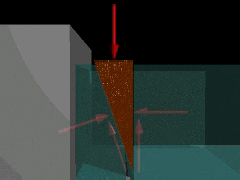| Ch 9. Friction | Multimedia Engineering Statics | ||||||
| Friction I | Friction II | ||||||
| Friction II | Case Intro | Theory | Case Solution | Example |
| Chapter |
| 1. Basics |
| 2. Vectors |
| 3. Forces |
| 4. Moments |
| 5. Rigid Bodies |
| 6. Structures |
| 7. Centroids/Inertia |
| 8. Internal Loads |
| 9. Friction |
| 10. Work & Energy |
| Appendix |
| Basic Math |
| Units |
| Sections |
| eBooks |
| Dynamics |
| Fluids |
| Math |
| Mechanics |
| Statics |
| Thermodynamics |
| ©Kurt Gramoll |
|
|
||
|
|
A wedge is a block with two flat faces that make a small angle with each other. Depending on the angle and the coefficients of friction acting on the wedge, the weight lifted can be many times the applied force P. Wedge problems can be often solved by using a semi-graphical approach that involves drawing the known vectors and using the laws of sines and cosines to find the unknown forces. Wedges are usually constrained against rotation. Therefore, only force equilibrium needs to be considered. Transferring forces by using wedges can often be considered in terms of mechanical advantage (M.A.) as M.A. = direct force / wedge force In this formula, the numerator is the amount of direct force needed to accomplish the task normally, and the denominator is the force applied to the wedge to do the same task. A well-designed wedge would have a mechanical advantage greater than one. However, wedges are often designed to remain in place after an applied load is removed. This type of wedge is called self-locking. Self-locking wedges often have a mechanical advantage less than one but are still viable designs. |
|
Practice Homework and Test problems now available in the 'Eng Statics' mobile app
Includes over 500 free problems with complete detailed solutions.
Available at the Google Play Store and Apple App Store.

